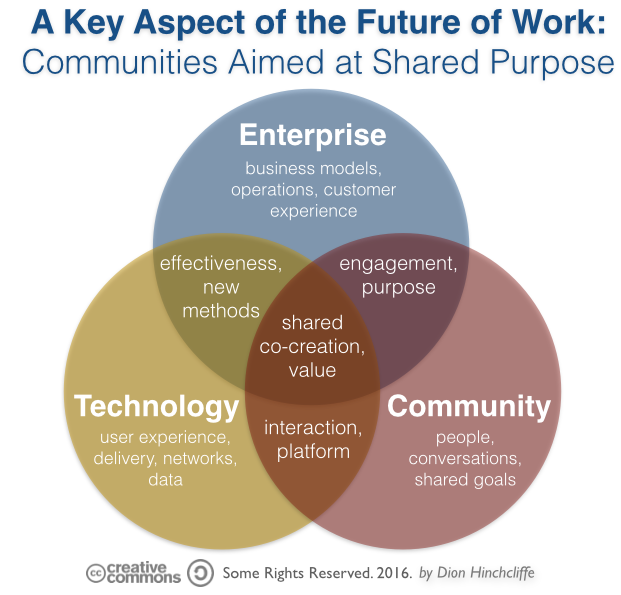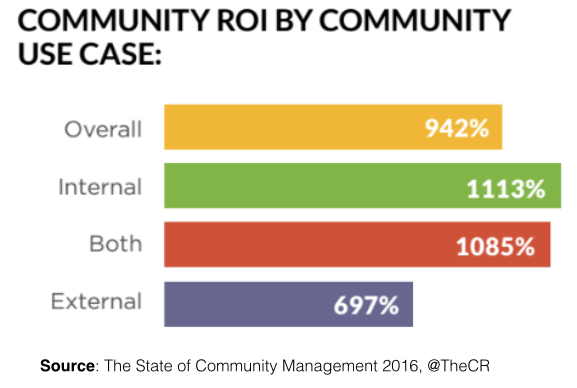More Evidence Online Community is Central to the Future of Work
June 5, 2016 1 Comment
Within the last month, two new industry reports have been released that shed important new light on how we’re going to be organizing and operating our organizations in the coming years. Many of you know my point of view in this regard: Social technology has at this point largely transformed the consumer world, yet the increasingly outdated digital landscape of business frequently continues to rely on creaky and rather limited technologies such as e-mail, document repositories, intranets, file sharing, and so on. So it’s always instructive to see how far we’ve actually come in places, and how much we have left to go.
The first report is The Community Roundtable’s excellent annual State of Community Management for 2016. While I’ll provide a fuller write-up on ZDNet soon, it’s clear from this report that the model of online community continues to rise in prominence and attention as a superior operating model for activities that involve a large number of people that have common interests and need to work together on shared objectives.
As my industry colleague Alan Lepofsky likes to say, without aiming our new digital technologies and cultures purposefully, there is little point.
Particularly significant in the report was this year’s exploration on the oft-discussed and little resolved issues of calculating hard return-on-investment (ROI) for community. While in my experience online community is a far superior — albeit still emerging — new way of working for a wide variety of use cases than traditional methods, both internal and externally facing, The Community Roundtable tackled the issue head on in this year’s report to determine ROI from this year’s participants in the survey:
While there is a wide range and many communities do have negative ROI rates that are likely due to their young age, small size or immaturity, many more demonstrate compelling returns that should satisfy stakeholders.
Successful internal communities are more valuable, on average, than their external facing peers and those community programs that addressed both audiences had an ROI in the middle. Overall, communities average an annual ROI of 942% – suggesting that most community managers have nothing to fear from calculating their community’s ROI – remembering that it is the start of an ongoing dialog about value and how to grow it.
The numbers overall are impressive, and shows what I’ve seen consistently: The return on community is not only enough to justify the initial investment and is superior to most competing methods, but is also more than enough to properly fund the ongoing effort with a properly sized team. This especially means dedicated, professional community managers, which are perhaps the top success factor for communities, yet too often neglected in my experience. In short, we can now quantify how online communities and enterprise social networks offer significant value to the typical business. In any case, the numbers make the case on their own:
From here we can see from the data, which Rachael Happe indicated to me recently in a discussion was from their largest sample size yet, is there is serious, immediate, and significant value in both internal and external communities. This continues to validate why online community should be a central plank of your digital strategy, and a core component of your digital transformation efforts.
Also, it’s worth noting that online community is also a key platform for enabling digital transformation, a key topic that came up last week in Paris by many practitioners at the Enterprise Digital SUMMIT, where I was speaking. I’ll explore that issue in more depth as well soon.
The value of social in the back office
The second report is “How social tools can reshape the organization” from the McKinsey Global Institute. Authored by well-known McKinsey partner Michael Chui — whom I finally got to meet recently in New Orleans at the Enterprise150 event — and several co-authors, the report delves into some recent findings on business impact with community and social tools that is worth exploring.
Particularly notable was the report’s finding that for any business activity which has been digitized, on average half report that incorporating social improves the digitized process even more, whatever the process. What’s more, specific business activities show a much higher level of improvement if they are digitized and made social, both (see chart above.) These activities include order-to-cash, demand planning, research & development (R&D), supply chain management, and procurement. These aren’t necessary glamorous aspects of our business, like marketing or sales, which are more often associated with social business performance but they are vital and important:
To digitize all processes, both internal and external, the results suggest that social tools can help. For every process where their companies are digitizing and using social tools, respondents agree that social technologies have enabled their use of digital overall. This is true even for the back-office processes where few respondents now say their companies are using social tools. In fact, social’s effect on digitization is greatest for the internal processes where social tools and digital activities are least common.
This data clearly shows that many efforts could be seeking higher levels of easily accessed value in places other than where we’ve traditionally focused. This also means that if you’re already digitizing something, it makes sense to make it social too.
Additional Reading: Enterprises need a (social) platform to drive change
In short, the case of online community is now stronger than ever: More data is available than ever before which shows substantial, sustained, and transformative value can be created by working in more open and highly participative models, as long as we’re sure to connect our activities to purpose. One of the things that struck me most in Paris last week is how many use cases that the latest case studies cite, far beyond simple knowledge sharing and management that used to be the central business case. It’s very encouraging to see our industry reach a new level of maturity and data-based value, though to be sure, there is still much more to do in most organizations.






























































Pingback: Customer Communities in 2016 | Workoutloud